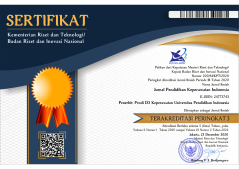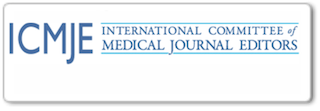Correlation between Nutritional States with Hematological Toxicity in Children with Acute Lymphoblastic Leukemia
Abstract
ABSTRAK
Status gizi pada anak dengan acute lymphoblastic acute (ALL) diketahui dapat mempengaruhi efek samping yang mungkin timbul setelah dilakukan kemoterapi. Salah satu efek samping yang sering terjadi pada anak dengan ALL pasca kemoterapi adalah hematological toxicity. Hematological toxicity adalah efek toksik yang ditimbulkan dari obat kemoterapi yang menyebabkan gangguan pada sel darah yang bila tidak diatasi dengan baik dapat menimbulkan kematian. Hematological toxicity sering terjadi pada anak ALL pasca kemoterapi namun belum menjadi perhatian tenaga kesehatan terutama perawat. Tujuan penelitian ini adalah ingin mengetahui hubungan antara status gizi dengan hematological toxicity pada anak ALL yang sedang menjalani kemoterapi. Penelitian ini dilakukan di RSUP Dr Hasan Sadikin Bandung pada bulan Desember 2016 dengan metode penelitian korelasi dengan pendekatan retrospektif. Penelitian ini dilakukan pada 198 responden yang diambil dari catatan rekam medis bulan Januari-Juli 2016 dengan menggunakan purposive sampling. Analisa data menggunakan uji Korelasi Spearman Rank (Rho). Hasil penelitian didapatkan 13 dari 17 responden berstatus gizi sangat kurus mengalami hematological toxicity dan terdapat hubungan yang signifikan antara status gizi dengan hematological toxicity pada anak ALL (p=0,015) dengan korelasi yang sangat lemah (r=-0,172). Kesimpulan: Terdapat hubungan antara status gizi dengan hematological toxicity pasca kemoterapi pada anak LLA yang menjalani kemoterapi. Oleh karena itu, pentingnya pengkajian status gizi dan monitoring tanda-tanda hematological toxicity untuk mencegah terjadinya efek buruk akibat dari pengobatan kemoterapi pada anak dengan ALL.
ABSTRACT
Acute lymphoblastic leukemia (ALL) is the most common cancer in children and one of the leading causes of death in children. Many factors affect the prognosis of acute lymphoblastic leukemia, one of which is the nutritional status. Nutrition status in children with acute lymphoblastic acute is known to affect side effects that arise after chemotherapy. One of the side effects which often occur in children with ALL post chemotherapy was hematological toxicity. Hematological toxicity was one of the side effect chemotherapy if not treated properly can caused death. The aimed of this research was to analyze the correlation of nutritional status with hematological toxicity on children with ALL in chemotherapy. This study was done in Hasan Sadikin General Hospital in Bandung in December 2016 with correlational research was performed with retrospective approach. 198 respondents were selected using purposive sampling taken from medical records during January-July in 2016. Data was analyzed using Spearman Rank Correlation Test (Rho). The study showed that 17 children with ALL were categorized in very thin (86,7%) suffered from hematological toxicity thus discovered significant correlation between nutritional status pre chemotherapy and hematological toxicity post chemotherapy in children with ALL (p=0,015) for a very weak correlation (r=-0,172). The conclusion in this study researched was that nutritional stated chemotherapy was correlated with hematological toxicity after chemotherapy in children with ALL. Therefore, assessment of nutritional status in children with acute lymphoblastic leukemia should be done especially when chemotherapy treatment is being taken to minimize the occurrence of hematological toxicity
Keywords
Full Text:
PDFReferences
Alcazar AM, Enriquez JC, Ruiz CA, Gutierrez AF & Arangure JM. (2013). Alteration of Nutrtional status in Childhood Acute Leukemia. Clinical Epidemiologi of Acute Lymphoblastic Leukemia Chapter 12. 277-296. doi:10.5772/52715
American Cancer Society. (2015). Global Cancer Fact & Figures (3nd Edition). Atlanta. Globocan. hlm 12-13
Asim M, Zaidi A, Ghafoor T & Qureshi Y. (2011). Death Analysis of Childhood Acute Lymphoblastic Leukemia ; Experience at Shaukat Khanum Memorial Cancer Hospital and Research Center, Pakistan. J Pak Med Assoc. 61 (7). 666-670p
Cancer Agency. (2015). Clinical Pharmacy Guide : Chemoterapy Assesment and Review 4th Edition. BC Cancer Agency. 1-6.
de Beaumais, T. A., Fakhoury, M., Medard, Y., Azougagh, S., Zhang, D.,
Yakouben, K., & Aigrain, E. J. (2010) Determinants of mercaptopurine toxicity in paediatric acute lymphoblastic leukemia maintenance therapy. British Journal of Clinical Pharmacology. 71 (4). 575-584p
Direktorat Bina Gizi dan Kesehatan Ibu dan Anak, K. (2012). Keputusan Menteri Kesehatan Republik Indonesia Nomor:1995/MENKES/SK/XII/2010 tentang Standar Antropometri Penilaian Status Gizi Anak. Jakarta: Kementerian Kesehatan RI. 1-40p
Hijiya N, Panetta JC, Zhou Y, Kyzer EP, Howard SC, Jeha S, dkk. (2006). Body mass index does not influence pharmacokinetics or outcome of treatment in children with acute lymphoblastic leukemia. Blood Journal. 108 (13). 3997-4002
Hossain MJ, Xie L & McCahan SM. (2014). Characterization of Pediatric Acute Lymphoblastic Leukemia Survival Patterns by Age at Diagnosis. Journal of Cancer Epidemiology. 1-9. Doi:10.1155/2014/865979
Isnani N, Perwitasari DA, Andalusia R & Mahdi IH. (2014). Evaluasi Toksisitas Hematologi Akibat Penggunaan 6-Merkaptopurin dalam Fase Pemeliharaan pada pasien pediatrik Kanker Leukimia Limfoblastik Akut di RS Kanker Dharmais Jakarta. Media Farmasi. 11 (1). 90-97p
Karch AM. (2011). Buku Ajar Farmakologi Keperawatan Edisi 2. Jakarta: EGC. hlm 189-218
Kementerian Kesehatan RI. (2011). Pedoman Penemuan Dini Kanker Pada Anak. Jakarta. Direktorat Jenderal Pengendalian Penyakit dan Penyehatan Lingkungan, Kementerian Kesehatan RI. hlm 5-8
Metha, A., & Hoffbrand, V. (2012). At a Glance Hematologi Edisi Kedua. Jakarta: Erlangga.
Miftahurachman & Wisaksana R. (2015). Hubungan antara indeks masa tubuh dan jumlah CD4 pada Penderita HIV yang mendapat pengobatan ARV. Bandung Medical Journal. 47 (4). 237-241p
Orgel E, Sposto R, Malvar J, Seibel NL, Ladas E, Gaynon PS, & Freyer DR. (2014). Impact on Survival and Toxicity by Duration of Weight Extreme During Treatmebt for Pediatric Acute Lymphoblastic Leukemia : A Report From the Children's Oncology Group. Journal of Clinical Oncology. 32 (13). 1331-1337.
Owens JL, Hanson SJ, McArthur JA & Mikhailov TA. (2013). The Need for Evidence Based Nutritional Guidelines for Pediatric Acute Lymphoblastic Leukemia Patients : Acute and Long Term Following Treatment. Nutrients. 5. 4333-4346. doi:10.3390/nu5114333
Roger PC. (2014). Nutritional Status As a Prognostic Indicator for Pediatric Malignancies. Journal of Clinical Oncology. 1-2p. doi: 10.12000/JCO.2013.52.6962
Sari TT, Windiastuti E, Cempako GR & Devaera Y. (2010). Prognosis Leukemia Limfoblastik Akut pada Anak Obes. Sari Pediatri. 12 (1). 58-62p
Simanjorang C. (2012). Perbedaan Ketahanan Hidup 5 tahun Pasien Leukemia Limfoblastik Akut dan Leukemia Mieloblastik Akut di Rumah Sakit Kanker Dharmais Jakarta Tahun 1997-2008 [tesis]. Depok: Univeristas Indonesia
Sulastriana, Muda S & Jemadi. (2012). Karakteristik Anak yang Menderita Leukemia Akut Rawat Inap di RSUP H.Adam Malik Medan Tahun 2011-2012. Medan: Universitas Sumatera Utara. In press
Wolley NGA, Gunawan S & Warouw SM. Perubahan Status Gizi pada Anak dengan Leukemia Limfoblastik Akut Selama Pengobatan. (2016). Jurnal e-Clinix (eCl). 4 (1). 1-8.
Wong DL, Eaton MH, Winkelstein ML, Wilson D & Schwatz P. (2009). Buku Ajar Keperawatan Pediatrik Volume 2. Edisi 6. Jakarta: EGC
DOI: https://doi.org/10.17509/jpki.v4i1.12339
Refbacks
- There are currently no refbacks.
Jurnal Pendidikan Keperawatan Indonesia(JPKI) published by Indonesia University of Education. JPKI is licensed under a Creative Commons Attribution-ShareAlike 4.0 International License.
Office :
Nursing Department. FPOK UPI.
229, Dr. Setiabudhi Street. Bandung 40154
West Java , Indonesia
E-mail : jpki@upi.edu

_.png)
_.png)
_.png)











